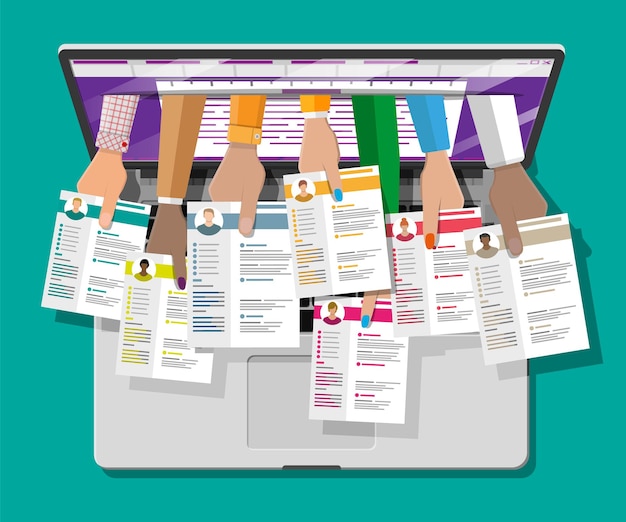Boost Your Job Search: Resume Tips for US Employers

Boost your job search by crafting a compelling resume tailored for US employers, highlighting relevant skills and experience to stand out in a competitive market.
Navigating the US job market requires a strategic approach, and your resume is your first impression. To boost your job search: crafting a winning resume that highlights your skills and experience for US employers is crucial for success. Let’s dive into how to make your resume a powerful tool in landing your dream job.
Understanding US Resume Expectations
The US job market has its own set of expectations when it comes to resumes. Understanding these nuances is key to ensuring your application is taken seriously.
Unlike some countries, US resumes typically focus on brevity and relevance. Hiring managers often spend just a few seconds reviewing each resume, so it’s essential to make those seconds count.
Key Differences in US Resumes
US resumes prioritize skills and accomplishments over lengthy descriptions. Here are some key differences to keep in mind:
- Length: Aim for a one-page resume, especially if you have less than 10 years of experience.
- Personal Information: Avoid including a photo or personal details like marital status or religion.
- Focus on Achievements: Quantify your accomplishments whenever possible to demonstrate your impact.
Tailoring your resume to align with these expectations will significantly increase your chances of getting noticed by US employers.
In summary, understanding US resume expectations involves focusing on brevity, quantifying achievements, and avoiding unnecessary personal information, all of which help make a strong and immediate impression.
Formatting Your Resume for Impact
The format of your resume is just as important as the content. A well-formatted resume is easy to read and highlights your most relevant qualifications.
Choosing the right format can make a significant difference in how your resume is perceived. A clean and professional layout ensures that your skills and experience are easily accessible.

Choosing the Right Format
There are three main resume formats to consider:
- Chronological: Lists your work experience in reverse chronological order, highlighting your career progression. Best for those with a consistent work history.
- Functional: Focuses on your skills and abilities, rather than your work history. Useful if you have gaps in your employment or are changing careers.
- Combination: Combines elements of both chronological and functional formats, showcasing both your skills and work experience.
Select the format that best represents your strengths and aligns with the job requirements. A carefully chosen format enhances readability and emphasizes what matters most to potential employers.
In conclusion, the right resume format can significantly impact how your qualifications are perceived, so it’s essential to choose a format that aligns with your strengths and ensures clarity and readability.
Crafting a Compelling Summary Statement
A summary statement, also known as a professional summary or objective, is a brief overview of your skills and experience at the top of your resume.
This statement is your opportunity to make a strong first impression and capture the attention of hiring managers. It should clearly articulate your value proposition and career goals.
What to Include in Your Summary Statement
- Relevant Skills: Highlight the key skills that match the job requirements.
- Years of Experience: Mention your years of experience in the industry.
- Career Goals: Briefly state your career objectives and how they align with the company’s goals.
A well-crafted summary statement provides a snapshot of your qualifications and motivates employers to read further. It should be tailored to each job application to maximize its impact.
In summary, a compelling summary statement is your chance to grab the attention of hiring managers by highlighting relevant skills, experience, and career goals, making it a crucial element of your resume.
Showcasing Your Skills Effectively
Your skills section is where you highlight your abilities and demonstrate what you bring to the table. It’s essential to showcase both hard and soft skills.
This section should be tailored to the specific job requirements and provide evidence of your capabilities. Including relevant skills can significantly increase your chances of getting an interview.

Listing Relevant Skills
When listing your skills, consider the following:
- Hard Skills: Technical skills and knowledge specific to the job, such as programming languages, software proficiency, or data analysis.
- Soft Skills: Interpersonal skills and personal attributes, such as communication, teamwork, problem-solving, and leadership.
- Keywords: Use keywords from the job description to ensure your resume is picked up by applicant tracking systems (ATS).
An effective skills section provides a comprehensive overview of your abilities and demonstrates your fit for the job. It should be clear, concise, and tailored to the employer’s needs.
In conclusion, effectively showcasing both hard and soft skills, while incorporating keywords from the job description, ensures that your resume stands out and aligns with the employer’s requirements.
Highlighting Your Work Experience
Your work experience section is where you detail your previous roles, responsibilities, and accomplishments. It’s crucial to present this information in a way that highlights your value to potential employers.
This section should provide a clear and concise overview of your career history, demonstrating your skills and achievements in previous roles. Quantifying your accomplishments can make a significant impact.
Quantifying Your Achievements
When describing your work experience, consider the following:
- Use Action Verbs: Start each bullet point with a strong action verb to describe your responsibilities and accomplishments.
- Quantify Your Achievements: Use numbers, percentages, and metrics to demonstrate the impact of your work.
- Tailor to the Job: Focus on the experiences and accomplishments that are most relevant to the job requirements.
A well-crafted work experience section provides evidence of your capabilities and demonstrates your value to potential employers. It should be clear, concise, and tailored to each job application.
In summary, highlighting your work experience involves using action verbs, quantifying achievements, and tailoring your descriptions to match the job requirements, all of which showcase your value to potential employers.
Proofreading and Optimizing Your Resume
Before submitting your resume, it’s essential to proofread it carefully and optimize it for applicant tracking systems (ATS).
Ensuring your resume is free of errors and optimized for ATS can significantly increase your chances of getting an interview. Attention to detail is crucial.
Tips for Proofreading and Optimization
- Check for Errors: Proofread your resume for spelling, grammar, and punctuation errors.
- Optimize for ATS: Use keywords from the job description and avoid using tables, images, or special characters.
- Seek Feedback: Ask friends, family, or career counselors to review your resume and provide feedback.
A polished and optimized resume demonstrates attention to detail and professionalism. It shows that you are serious about the job and have taken the time to present yourself in the best possible light.
In conclusion, proofreading for errors, optimizing for applicant tracking systems, and seeking feedback are essential steps to ensure your resume is polished, professional, and effective.
| Key Point | Brief Description |
|---|---|
| 🎯 Tailor Your Resume | Customize your resume for each job application. |
| 🏆 Quantify Achievements | Use numbers and metrics to showcase your impact. |
| ✨ Relevant Skills | Highlight both hard and soft skills from the job description. |
| ✅ Proofread Carefully | Check for errors and optimize for applicant tracking systems. |
Frequently Asked Questions (FAQ)
▼
Ideally, your resume should be one page if you have less than 10 years of experience. If you have more extensive experience, you can consider using two pages, but keep it concise and relevant.
▼
In the US, it is generally not recommended to include a photo on your resume unless you are applying for a job where appearance is a key requirement, such as acting or modeling. Focus on your qualifications and skills instead.
▼
Applicant tracking systems are software applications used by employers to collect, sort, and rank job applications. To optimize your resume for ATS, use keywords from the job description and avoid using special characters or images.
▼
Quantifying your achievements involves using numbers, percentages, and metrics to demonstrate the impact of your work. For example, instead of saying “Improved sales,” say “Increased sales by 20% in six months.”
▼
In your skills section, include both hard skills (technical skills and knowledge) and soft skills (interpersonal skills and personal attributes). Tailor this section to match the requirements listed in the job description.
Conclusion
Crafting a winning resume for the US job market requires careful attention to detail, a focus on relevance, and a clear understanding of employer expectations. By following these tips, you can boost your job search: crafting a winning resume that highlights your skills and experience for US employers, setting yourself up for success in your job search journey.
